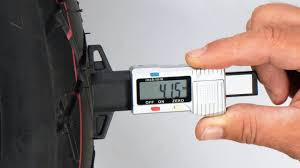As you know that tyres are the only point of
contact between a vehicle and the road, making their design and specifications
crucial for performance, safety, and comfort. One of the most important tyre
parameters is the NSD (Non-Skid Depth), also known as tread depth.
It refers to the depth of the grooves or patterns on the tyre tread, which
plays a vital role in grip, water dispersion, braking efficiency, and overall
road safety. NSD varies depending on several factors, including the type of
vehicle (two-wheeler or four-wheeler), the tyre size, load capacity, and
intended use (urban, highway, off-road, etc.).
Here get an introduction to how your tyre NSD is decided in different tyre
sizes across two-wheelers and four-wheelers, shedding light on industry
standards, safety considerations, and practical implications.
Understanding
NSD (Non-Skid Depth)
Non-Skid Depth (NSD) is the measurement of the vertical distance between the top of the tread rubber to the bottom of the tread groove.
It is usually measured in millimeters (mm). A higher NSD generally means the tyre can last longer and perform better under wet or rugged conditions. However, excessive tread depth can sometimes lead to reduced steering precision and increased rolling resistance.
The standard NSD for a brand-new
tyre depends on the tyre category:
· Two-wheelers
Generally, new tyres have an NSD ranging from 4
mm to 6 mm.
· Passenger cars (four-wheelers):
New tyres usually have an NSD of 7 mm to 9
mm
· SUVs and commercial vehicles:
These have a higher NSD, typically between 9
mm and 15 mm due to the load they carry and the terrains they operate on.
How
NSD is Decided for Two-Wheelers
Tyres for motorcycles and scooters
are smaller in width and diameter compared to cars. The NSD for two-wheeler
tyres is determined based on the following factors:
1.
Tyre Size and Profile
Tyre size determines the contact
patch with the road. A tyre with a higher width may have slightly deeper tread
to balance the contact surface and wear rate. For example:
·
A 90/90-12 scooter tyre may
have an NSD of around 4 mm.
·
A 110/80-17 motorcycle tyre
may have an NSD of 5 mm to 5.5 mm.
2.
Vehicle Type and Purpose
Sport bikes, off-road bikes, and
commuter bikes have different tread depth needs:
·
Sport
bikes focus on grip and cornering, so the
tread is usually shallower with slick patterns.
·
Off-road
or dirt bikes require deeper NSD (sometimes up to
7 mm) for traction on loose surfaces.
·
Commuter
bikes need moderate NSD (around 5 mm)
for durability and mixed terrain.
3.
Riding Conditions and Tyre Compound
Urban and highway tyres for
two-wheelers often have NSD designed for dry and wet surfaces, providing
optimum grip while ensuring a smooth ride. Harder compounds may need deeper
treads to compensate for slower wear.
How
NSD is Decided for Four-Wheelers
In passenger cars, SUVs, and
commercial vehicles, NSD becomes even more important due to higher speeds,
weights, and varied driving conditions.
1.
Tyre Size and Load Index
The width, aspect ratio, and rim
diameter all influence the NSD design:
·
A 175/65 R15 tyre (for
hatchbacks and sedans) usually has an NSD of 7.5 mm to 8 mm.
·
A 205/60 R16 SUV tyre may
have an NSD of 8 mm to 10 mm.
·
Commercial vehicle tyres, like 235/75
R17.5, can have NSD values up to 14 mm or more.
Larger tyres typically have deeper
NSD to support more load and provide longer life.
2.
Vehicle Type and Application
·
Passenger
Cars: Designed for smooth roads, fuel
efficiency, and comfort. Standard tread depth ranges from 7 to 9 mm.
·
SUVs and
Pickup Trucks: These vehicles need better
off-road capability and higher durability. Their tyres have deeper treads and
rugged designs.
·
Commercial
Vehicles (buses and trucks): Deep NSD
of 10–15 mm helps in managing heavy loads and long travel distances.
3.
Tyre Category: Summer, All-Season, Winter, Off-Road
- Summer tyres:
Usually have a shallower NSD (~7 mm) for better grip and reduced rolling
resistance.
- All-season tyres:
NSD around 8 mm for balanced performance.
- Winter tyres:
Often deeper (up to 10 mm) to handle snow and slush.
- All-terrain/off-road tyres: Designed with aggressive patterns and deep NSD (12–15
mm) for maximum grip.
Legal
Minimum NSD Limits
Each country or region has legal
requirements for minimum tread depth, to ensure road safety:
- India:
Recommended minimum tread depth is 1.6 mm for all vehicles.
- Europe:
Legal limit is 1.6 mm for cars and 1 mm for motorcycles.
- USA:
Legal limit is 2/32 inch (~1.6 mm).
Tyres below the minimum NSD are
considered unsafe and should be replaced immediately.
Measurement
and Monitoring of NSD
NSD can be measured using tools
like:
- Tread depth gauges
(digital or analog)
- Tread wear indicators (TWI) on the tyre itself
Drivers should regularly inspect
their tyres for wear and ensure all four (or both for two-wheelers) have
consistent tread depth. Uneven NSD could indicate alignment or suspension
issues.
Factors
Influencing NSD Design and Selection
Tyre manufacturers use a combination
of engineering, road testing, and simulation to decide the optimal NSD for a
specific tyre model. Some key factors include:
1. Tyre Material and Rubber Compound
Different rubber compounds wear at
different rates. Soft rubber offers better grip but wears faster, so a slightly
deeper NSD may be applied to extend tyre life. Harder compounds are more
durable but may have lower grip, so the NSD must be optimized for safety and
performance.
2. Speed Rating and Performance Expectations
High-speed performance tyres for
sports cars or performance motorcycles often have shallower treads with
specialized patterns. Their NSD is designed not for longevity, but for maximum
road contact and heat resistance. In contrast, touring or all-terrain tyres
have deeper treads to accommodate varied conditions and longer journeys.
3. Climate and Environmental Conditions
·
In hot climates, tyres may wear
faster due to increased road temperature, so a moderately deeper NSD is
preferred.
·
In cold or wet regions, a deeper
tread helps improve water evacuation and reduce the risk of hydroplaning.
·
Snow tyres often have special sipes
and deeper NSD to handle slush, snow, and ice.
4.
Noise and Comfort Considerations
Tyres with deeper treads can
sometimes generate more road noise, especially on smooth highways. Therefore,
manufacturers balance NSD with tread pattern design to reduce noise levels
without compromising safety.
Retreading and NSD in Commercial Applications
In heavy-duty four-wheelers like
buses and trucks, NSD is critical not only for safety but also for cost
efficiency. Many commercial tyres are designed to be retreaded—a process
that involves removing worn tread and adding new tread rubber to extend the
tyre’s usable life.
Retreading requires a base tyre
(known as the casing) that still meets certain conditions, including:
·
A minimum remaining NSD.
·
Structural integrity of the sidewall
and bead area.
Proper NSD tracking helps fleet
managers decide the best time for retreading to maximize return on investment.
NSD
and Fuel Efficiency
Another often-overlooked aspect of
NSD is its impact on fuel consumption. Tyres with excessive tread depth
can increase rolling resistance, leading to slightly higher fuel consumption.
Conversely, tyres with very shallow tread (especially when nearing the legal
limit) may reduce grip and increase braking distance, making them unsafe.
Manufacturers aim to strike a
balance between grip, rolling resistance, and tread life by designing the NSD
specifically for the tyre’s intended use.
NSD
Maintenance Tips for Vehicle Owners
To get the best performance from
your tyres and ensure safe driving conditions, follow these tips:
1.
Inspect Tread Depth Monthly
Use a tread depth gauge or the built-in Tread Wear Indicators (TWIs)
that appear as small rubber bridges in the grooves. If they become flush with the tread surface, the tyre is due for replacement.
2. Rotate Tyres Regularly
Front and rear tyres wear at
different rates. Rotating tyres every 8,000 to 10,000 km helps ensure even NSD
across all tyres and extends their overall life.
3. Check Wheel Alignment and Suspension
Uneven NSD across one tyre can be a
sign of alignment or suspension issues. It’s best to get your vehicle checked
if you notice uneven wear.
4. Maintain Correct Tyre Pressure
Under-inflation or over-inflation
can lead to abnormal tread wear, affecting NSD and safety. Check tyre pressure
at least twice a month and before long journeys.
Role
of Regulatory Bodies in NSD Standards
In many countries, regulatory bodies like BIS (Bureau of Indian Standards)
, DOT (Department of Transportation - USA)
, and ECE (Economic Commission for Europe)
provide guidelines for tyre performance, including tread design, depth, and durability.
Tyres are tested for:
·
Minimum NSD based on category and
use.
·
Resistance to aquaplaning.
·
Grip on wet and dry surfaces.
·
Wear resistance over standardized
test distances.
These regulations help ensure that
tyres sold in the market meet minimum safety benchmarks for NSD and related
factors.
Future
Trends in NSD and Tyre Technology
As automotive technology evolves, so
does tyre engineering. Here are some upcoming trends in how NSD is managed and
utilized:
1. Smart Tyres with NSD Sensors
Tyres embedded with RFID chips and
sensors can now monitor real-time tread depth and alert drivers when
replacement is needed. This is particularly useful in fleet management.
2. 3D Printed Treads and Custom NSD
Advanced manufacturing techniques
may allow customized tread depths and patterns for specific user needs,
offering better grip, comfort, and fuel efficiency.
3. Eco-Friendly Tyres with Optimized NSD
With a focus on sustainability, tyre
makers are developing eco-friendly compounds and NSD profiles that maintain
grip while reducing rubber usage and carbon footprint.
Final
Thoughts
Non-Skid Depth is much more than just
a number—it is a crucial design element that determines how safe, efficient,
and durable a tyre is. Whether you drive a scooter, a sedan, or a commercial
truck, understanding NSD can help you choose the right tyres, maintain them
properly, and avoid potential road hazards.
As a responsible driver, always pay
attention to tread wear, rotate your tyres at regular intervals, and replace
them when they approach the legal or recommended tread depth. In doing so, you
not only ensure your safety but also enhance the performance and fuel economy
of your vehicle.
Conclusion
NSD is a crucial parameter in tyre
design, influencing performance, safety, and longevity. Whether it’s a scooter
navigating city traffic or a heavy-duty truck covering long distances, the
correct NSD ensures proper traction, braking, and comfort. Tyre manufacturers
consider various factors—vehicle type, tyre size, load capacity, terrain, and
usage—when designing the tread depth for each tyre category.
As a vehicle owner, understanding
NSD and monitoring it periodically helps maintain road safety and reduces the
risk of accidents, especially in wet or slippery conditions. Always replace
tyres before they wear down to the minimum legal tread depth, regardless of
external appearance.
Disclaimer
The information provided in this blog
is for general awareness purposes only. Actual NSD values and regulations may
vary based on tyre manufacturer, region, road safety laws, and specific vehicle
requirements. Always consult your vehicle manual or tyre manufacturer for exact
specifications. The blogger is not liable for any damages or accidents
resulting from improper tyre usage or maintenance.


.png)























0 Comments